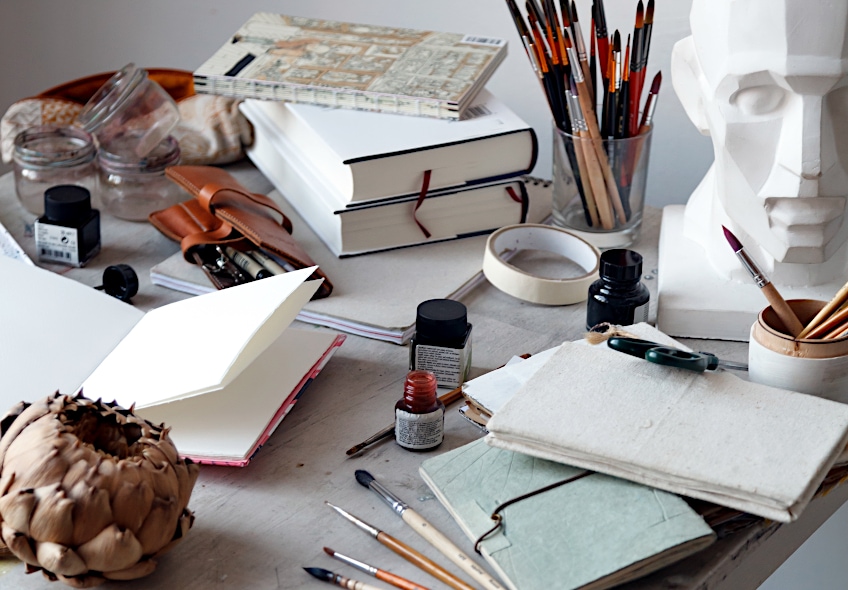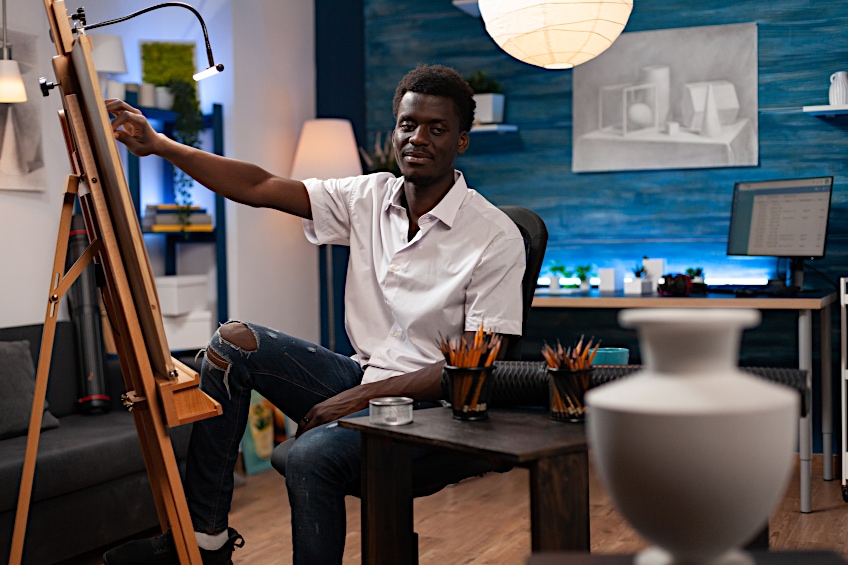How to Find Your Art Style – Develop a Unique Creative Voice
This post may contain affiliate links. We may earn a small commission from purchases made through them, at no additional cost to you.
How to find your art style can be a confusing and overwhelming question in becoming more creative in your life. You need to think about all styles of art and develop one that sets you apart from other creative people. There are so many different art styles that it can be difficult to know where to start. But this process of, for example, exploring various styles of paintings if you want to become a painter, is also a very exciting part of figuring out your artistic identity, voice, and contribution to the world of art. In this article, we will explore all the fun and exciting ways how to your art style while giving practical tips about going through this process.
Table of Contents
How to Find Your Art Style
There are as many art styles as there are individual artists. Your art style can also be called your artist identity. It is what makes you recognizable and unique as an artist. When finding your art style, it is important to consider what it is you want to say and do as an artist. Considering your artist identity is important if you want to be remembered, want buyers to collect your art, and if you are an artist that uses different art mediums there needs to be a way for all your work to read together as one body of work.

Finding and building a recognizable art style can also help you to attract the specific audience your work resonates with. If you are the kind of artist that wants their work to be accessible and use social media, for example, as a marketing tool, it can be helpful to consider how your art style reflects accessibility. If you want to work closely with interior designers to get your art into glamorous houses in magazines, you need to look at trends and color palettes that are in fashion. There are many things to consider before you solidify your art style, like sustainability, access to materials, changing trends, and so on.
It helps to start with the basic principles of your art style like the aesthetic art style, your chosen subject matter, branding, communication, and conceptualization.

First Step in How to Find Your Art Style: Explore
Research and exploration are a vital part of finding your art style. Before you decide on your identity as an artist it is important to explore as many medium styles as possible. The medium you work in as an artist can range from more traditional medium styles like performance art, poetry, dance, drawing, and painting to contemporary medium styles like street art, multimedia art, and installation. Equipping yourself with as many art skills as you can will help you reach a clear and refined art style. This also involves considering whether you want to make what is considered “beautiful” art.
Researching different aesthetic styles in your area and the world at large can be helpful in understanding how you want to make art.
Styles of Art Involve Different Medium Styles
Getting to a place where what you do is coherently communicated to your audience requires a lot of focused work. Medium styles can be split into multiple subcategories of a specific art style. For example, styles of paintings can be split into subcategories like impressionism, surrealism, realism, romanticism, landscape painting, and so on. That is why it is important to experiment and play with as many different mediums as possible before you decide.

This is where a visual diary or specific digital folder on your computer comes in handy. When you are exploring different ways of making art it is useful to have a space where you can compare these explorations. Even when you are exploring a single medium, such as drawing, you need to research and try all the different styles of drawing. This way your style of mark-making, for example, will become distinct to you. These insights can then inform further exploration in other mediums. You can take what you have learned from exploration in one medium to the next medium and note down in your visual journal what you notice.
There is no right or wrong way to do this exploration, so you can release control and have fun!

Reflect on the following questions in your visual diary when you are doing medium research:
- What is my art style at the moment?
- How do I feel when I use this medium? Is it easy for me to express myself using this medium? Does using this medium come naturally, or do I need to spend more time studying it?
- Am I intrigued by this medium? Will I be able to use it for many years? Will I return to this medium even after I explore other mediums?
- Are there ideas for artworks I can make using this medium that come up in my mind while I explore using it?
- Are there more art styles to try that will challenge my medium exploration?
After you have explored for a while, decide on a medium and commit to it for a certain amount of time. The longer you practice in a specific medium, the easier it will be for people to start associating you with that medium. Artists often reach a block in their practice when they feel bored or challenged. Before changing your art style consider working through these blocks as changing your style too often can make your work confusing.
Considering Aesthetic Styles of Art
There are many different styles of art and all of them involve an understanding of aesthetics. Aesthetics is the study and perception of beauty. Trends in what is considered aesthetics change throughout time and are also determined by the culture found in a specific geographic location. However, there are larger global trends in what is deemed aesthetic. Even though not all art has to be beautiful, it is always read in relation to the current understanding of aesthetics (whether global or local). Reading about trends in your country, city or town can be a formative aspect of finding your art style, as it will bring up questions about how you want to position your work concerning aesthetics.
When considering aesthetics, you can decide whether you want to work with particularly aesthetic art styles that might be more appealing to popular buying markets or want to work with more challenging art styles that might attract a niche market.

Taste and sensibility for what is deemed beautiful can be developed by looking at as many different kinds of art styles as possible. Attending galleries in your area can help you understand what is considered beautiful by your local community. Looking at prominent galleries’ art exhibitions online can create an understanding of what is considered desirable by the global art market. When you attend gallery openings, art competition announcements, and art fairs note down in your visual diary what you observe aesthetically about the art on show.
Reflect on the aesthetic quality of the work you are drawn to as well.
Clarifying questions in determining aesthetic style could include:
- Is the artwork inviting to look at?
- Is it the texture, color, composition, or subject matter that is pleasing to look at?
- Does this gallery/community/fair prefer art that aligns with traditionally aesthetic art styles or that is edgy and difficult to look at?
- What am I drawn to?

After considering the aesthetic value of what you or a market is drawn to, you can study art principles that contribute to aesthetic values. Decisions about the color palette, composition, texture, line, and form influence the aesthetic appeal of your artworks.

Narrowing down your color palette at the beginning of establishing your art style can be helpful. Limiting your color use illuminates the option paralysis that often comes with using the whole spectrum of color. Whether you want to work with complementary colors, contrasting colors, or shades of the same color is important to think about when establishing your art style.

In terms of composition, you can think about perspective, triangulation, and juxtaposition. Try different crops of artworks and see how their aesthetic sensibility changes. Texture, line, and form can guide the eye of the viewer, adding to a pleasant viewing experience, or it can disrupt the viewing experience. Consider whether you want your art to be easy to look at or challenging, inviting a closer look.

There is no right or wrong in the process of defining the way you express yourself. It is important to consider the trajectory of your career. Choose where to start with your art style while imagining where you want to go with your art. You can choose an art style that you feel comfortable spending some time developing. You can also create disruptions and challenges for yourself as your practice deepens to make sure you do not get too comfortable. Here your visual diary can be a catalyzing tool again. If you start noticing trends in your tastes and interests you can reflect on them in writing and process art.
Once you have limited your color palette to feel more comfortable, you can use these colors (or at least a few of them) in the branding and communication part of establishing your art style. The elements of composition, texture, form, and line can also all become handing branding elements that communicate your art style.
The What: Subject Matter Matters
After you have considered the medium style and aesthetic sensibility of your art you can think of what you want to depict. In the beginning, when you are still in the process of figuring out how you make art, the subject matter is not as important.
It might be interesting to try out different drawing styles by using the same object every time or test out styles of paintings by simply painting whatever is interesting to you at that moment.
However, you might want to do the medium and aesthetic exploration by having a specific subject in mind. It does not matter, as long as keeping a subject in mind does not become a block how freely you explore different mediums and aesthetic styles. Once you have made decisions about the use of palette, crop, texture, form, and line you can hone in on how these elements will interact and influence a specific subject matter.

Choosing a subject matter can be hard, but it is important to choose something that will hold your attention while you establish yourself as a practicing artist. Subject matter can range from something specific like only painting still-life or more theoretically charged topics like the politics and ideologies surrounding the depiction of the female body.

The subject matter of your art links directly to what you want to communicate to the world. Therefore, it is important to carefully think about what you want to depict in your art. Subject matters can range from being deeply personal to having environmental significance in the larger context. The subject matter of your art can be abstract, but how you communicate and write about your art needs to be clear. This is where conceptualization and branding come in.
The Why: Telling the Story
The message you want to share through your art is an important aspect of your art style. Getting to this message requires reading about art and writing a lot about your work. You can make brain maps that reflect on the look and feel you develop in your work by applying the knowledge we discussed above. You can add concepts to this mind map that you want to explore further in your body of work.

Conceptualization of Different Art Styles
The concept that your work explores can also be a worthwhile area of exploration in finding your art style. The concept of a body of work or specific artwork differs from the subject matter. The subject matter is what you see or what an artist physically depicts. Where concept has to do with the message, symbolism of values the artwork aims to reflect. If you want to paint flowers simply for the joy of painting flowers that is perfectly allowed.
But if you want to write a story or message about your art, you should consider your concept.

Connecting the concept of joy to paintings that were simply fun to make, is a form of conceptualization. It gives the painting emotional, symbolic, political, and sometimes spiritual meaning. The work by artists that choose to not write conceptual reasonings still gets conceptually interpreted by viewers. Humans are story creatures. We can, and often want to, read meaning in everything. Carrying deeper meaning is also one of the oldest functions of art. Therefore, reflecting on the concepts you explore in your art can be a fun and stimulating exercise. Reading other artists’ conceptual reasonings can help you formulate your concepts.

Once you have narrowed down the concepts or messages you want to communicate through your art it is vital to write as much as you can about your work. Do not assume people understand why this is important to you or the world at large. In your initial texts write the full story of how you decided to use the concepts you employ in your art process. This is a very useful exercise in thinking through the way you practice. Through writing, you can also more easily see gaps in your artistic study and develop your work more actively. You can always edit your conceptual reasoning when you start entering competitions and galleries.
You can also choose to not consider the conceptualization of your art at all. Conceptual art is a fairly modern art modality and you do not have to incorporate concepts into your art style. You can leave your art open for interpretation and work intuitively. This is also an art style. Many artists simply create what they want to create and allow the audience to make sense of the meaning themselves.
Artist Values
Artists are more than just the artworks they create. Their creativity seeps into their lives in different ways and makes them teachers, curators, mentors, bakers, gardeners, and so on. Their practice and creativity involve a set of values that influences their art process. For example, a painter might be convinced that creativity is an excellent educational tool and start teaching to explore this artist’s value; a sculptor might be convinced that art is a form of meditation and start sharing sculpting meditations with the world through YouTube.

This part of your practice might not visually be represented in the communication of your art style but is important to consider because they add to the essence of your work. They will creep in texts that you write, conversations that you have, and relationships that you build around your art. People remember how you make them feel. Your art has the function to evoke, but you as the artist influence what is evoked. Therefore, it is important to reflect on your philosophies and values as a creator in the process of finding your art style.
Branding
Whether you consider your artist identity or your art practice as a brand, it is vital to consider how you frame your work for the world’s consumption. Framing yourself means creating a context for your artworks. Considering your background, artistic values, as well as the message you want to relay with your artworks are all key topics in creating a definitive art style. All of this is communicated through your brand identity on your website or social media.
Your brand does not have to be a graphic presentation of your artwork but can be communicated in subtle elements in your catalog and on your website. Considering consistency in color, font and layout can all add to your brand identity. You can work all the insights gained from medium, aesthetic style, concept, and artist values into your brand identity. A brand is important if you want to sell your art, but it is not vital in finding your art style.
Honing In
Once you have considered all the different elements of your art style, it could be a worthy exercise to make all of what you discovered even more streamlined. We are constantly flooded with information through internet news, TV, and social media. That’s why creating a simplified and direct art style can help you stand out among all the other artists.
Instead of hiding away from the question, “what is my art style?”, take on the task of exploring different art styles as the first commitment to your art practice. Finding your art style can feel like a big project, but going through all the steps of refining your artist identity helps bring focus and integrity to your practice. Remember that defining your art style is also a creative act, so curiosity and play are vital in getting to your authentic artistic voice. You can also reconsider all of the elements that make up your art style. Flexibility and continuous exploration are key to being an artist, so do not take yourself too seriously when you are starting your art career. Keep your concepts, subject matter, and visual style close to who you are, that is why you will feel more centered in your artistic expression.
Frequently Asked Questions
What Is my Art Style?
Your art style is a combination of your choice of medium, subject matter, aesthetic style, conceptual reasoning, and communication about your art to the world. Your art style can include styles of paintings, dancing, photography, and more, but should all be brought together under one visual identity.
Is There a Short Recipe for Finding Your Art Style?
Finding your art style requires time and committed focus. There is no quick fix in developing the clarity of the artwork you put out in the world. But you can follow a simplified recipe to get find your art style. Firstly, get to know your skill. You can do this by exploring styles of paintings, drawing, sculpting, and so on before deciding on one. Then develop the skill you have in that medium. Secondly, get to know yourself. Think about your artist values and the concepts you want to represent. You then need to get to know your subject. Decide what you want to depict in your artwork. Combine all of the above prompts in a simplified message on your website, CV, or social media.
There Are So Many Art Styles to Try, How Do I Know Which One I Resonate With?
The only way to find out which art style you like is to try as many as you possibly can. Once you have tried different drawing styles, styles of painting, photography, printmaking, sculpting, and so on, you will probably reach a point where you want to return to a specific art style. That is how you determine what style you resonate with. Finding your medium style is like finding a second of communication. Enjoy the first part of exploring the medium, follow your pleasure. And then, once you have developed your skill, start challenging yourself to create nuance in your art style.
How Do I Make Sure I Do Not Get Stuck in a Specific Art Style?
Once you have reached a clear art style make sure you look at the places where you are stuck. After creating in your comfort zone in terms of medium, subject matter, and concept, you can create challenges for yourself. Go towards the places you are scared of. For example, if you have a block in exploring bodies in your art style, challenge yourself to commit time to studying bodies after a few years of practicing what comes naturally. Are there more art styles to try? Ask yourself this question and go towards what feels scary and hard.
Megan is a writer and researcher who graduated from the University of Cape Town with a degree in Social Sciences, specializing in Psychology and Environmental Science. Her passion for knowledge and leaving a positive impact has fueled her current work in conscious and sustainable growth in Southern Africa. Megan’s love of nature has also led her to train as an animal behaviorist. She works part-time training and rehabilitating dogs. Megan is interested in the physical and psychological effects of colors in our environment on our mood and well-being. In addition, she is concerned with how art and creativity have been an integral part of human society. Megan van Schoor has been writing blog posts on the topics of painting, drawing, and color theory for acrylgiessen since 2021.
Learn more about Megan van Schoor and about us.







